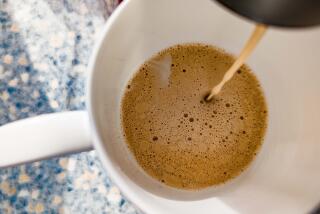Cyclone, Rain Add Spice to Vanilla’s Price
WASHINGTON — The Totonaca Indians in ancient Mexico were enchanted by its scent. Spanish colonists in Mexico during the 1500s fell in love with its sweet, soothing flavor after tasting it in cacao, a chocolate drink.
Centuries later, plain old vanilla has become a key ingredient in hundreds of foods, and even items such as candles and perfume. Cakes, pastries, glazes and sauces would not be as tasty without it.
Vanilla isn’t cheap, though. With recent price jumps, food processors and commercial cooks are paying as much as $150 a pound for pure vanilla -- nearly six times what it cost just three years ago.
Consumers who buy vanilla for their kitchens have seen the price for a 4-ounce bottle of pure vanilla at the supermarket climb to as much as $20, compared with $6 a few years ago.
The food industry blames the price jump on a series of bad growing seasons in Madagascar, the No. 1 vanilla-producing country.
Crops in Madagascar were damaged in 2000 by a cyclone. The storm wiped out more than 30% of the vanilla crop and destroyed storage houses containing much of the inventory on the Indian Ocean island.
Madagascar usually exports nearly 4 million pounds each year and supplies 75% of the world’s vanilla.
Since the cyclone, bad weather has continued to hinder a full recovery, said Laurie Harrsen, spokeswoman at McCormick & Co., a spice company in Maryland. Over the last two years, rain has drenched the island just when the vanilla plants were about to bloom -- the time when they need sunshine the most.
“One bad year of a crop, people can pretty much recover from. This has been happening for the last couple years,” she said.
Growth of Madagascar’s vanilla has also been hampered because it takes new plants three years to start producing beans. Plus, it is no ordinary crop. The spice grows on an ivory-blossomed orchid, vanilla planifolia. Farmers have to pollinate the tropical plant by hand, otherwise it will not produce beans.
Patricia Rain, who is writing a book about the history of the spice, noted that timing is everything when it comes to pollination.
“It blooms by 5 or 6 in the morning and wilts by the afternoon, and dies by 5 or 6, unless it’s pollinated,” said Rain, who also owns a vanilla sales business, the Vanilla Company in Santa Cruz.
She said the fruit, which resemble big green beans, must stay on the vine for nine months to mature. But the beans do not develop their signature, sweet floral aroma and flavor until they have been cured and dried.
Restaurants, food processors, chefs and consumers can turn to artificial vanilla, which can sell for one-fourth of the price of real vanilla. Some die-hard purists, however, are reluctant to use substitutes even though they have the Food and Drug Administration’s approval.
A key ingredient, vanillin, is the basis for making artificial vanilla. It is found in real vanilla, but also is a byproduct of wood pulp manufacturing. The fake flavor is made by mixing vanillin into an alcohol solution.
Arnold Carbone, director of research and development at ice cream-maker Ben & Jerry’s, said the Vermont company will not consider using artificial vanilla flavors despite the high cost.
“We have no desire to use anything other than pure vanilla,” he said.
He added that the company is paying such low prices for dairy ingredients that it can offset the rising price of vanilla, so “the hit’s not as big on us.”
Mary Ellen Camire, a food scientist at the University of Maine, said connoisseurs can easily spot the difference between imitation and real vanilla. They may even be able to tell where real vanilla was produced.
“It’s like wine,” she said. “Planting it in different places, it gives you different flavors.”
Chefs and consumers who want to save money on vanilla by buying it in Mexico and other vanilla-producing countries must be careful.
Barry Swanson, a food scientist at Washington State University, said he and other scientists have found some foreign products labeled as pure vanilla come from the tonka plant. It is a pungent product that contains a risky compound called coumarin.
Swanson said studies show that it leads to liver damage in lab rats.
More to Read
Eat your way across L.A.
Get our weekly Tasting Notes newsletter for reviews, news and more.
You may occasionally receive promotional content from the Los Angeles Times.








